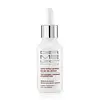What's inside
What's inside
 Key Ingredients
Key Ingredients

 Benefits
Benefits

 Concerns
Concerns

No concerns
 Ingredients Side-by-side
Ingredients Side-by-side

Aloe Barbadensis Leaf Juice
Skin ConditioningWater
Skin ConditioningPropanediol
SolventSqualane
EmollientGlycerin
HumectantSodium Citrate
BufferingBeta-Glucan
Skin ConditioningLysolecithin
EmulsifyingSclerotium Gum
Emulsion StabilisingPullulan
Xanthan Gum
EmulsifyingCeramide NP
Skin ConditioningCeramide Ns
Skin ConditioningCeramide AP
Skin ConditioningCeramide Eos
Skin ConditioningCeramide EOP
Skin ConditioningMusa Sapientum Leaf Extract
Skin ConditioningTocopherol
AntioxidantCalcium Gluconate
HumectantCetyl Alcohol
EmollientCaprylyl Glycol
EmollientCeteareth-25
CleansingArginine
MaskingSilica
AbrasiveCaprooyl Phytosphingosine
Skin ConditioningCaprooyl Sphingosine
Skin ConditioningCholesterol
EmollientGluconolactone
Skin ConditioningLactic Acid
BufferingHelianthus Annuus Seed Oil
EmollientSodium Benzoate
MaskingBehenic Acid
CleansingAloe Barbadensis Leaf Juice, Water, Propanediol, Squalane, Glycerin, Sodium Citrate, Beta-Glucan, Lysolecithin, Sclerotium Gum, Pullulan, Xanthan Gum, Ceramide NP, Ceramide Ns, Ceramide AP, Ceramide Eos, Ceramide EOP, Musa Sapientum Leaf Extract, Tocopherol, Calcium Gluconate, Cetyl Alcohol, Caprylyl Glycol, Ceteareth-25, Arginine, Silica, Caprooyl Phytosphingosine, Caprooyl Sphingosine, Cholesterol, Gluconolactone, Lactic Acid, Helianthus Annuus Seed Oil, Sodium Benzoate, Behenic Acid
Water
Skin ConditioningPentylene Glycol
Skin ConditioningPropanediol
SolventSodium Lactate
BufferingGlycereth-26
HumectantGalactoarabinan
Camellia Sinensis Leaf Extract
AntimicrobialSymphytum Officinale Leaf Extract
Skin ConditioningAloe Barbadensis Leaf Extract
EmollientGlycerin
HumectantPhenoxyethanol
PreservativeEthylhexylglycerin
Skin ConditioningTocopherol
AntioxidantDehydroxanthan Gum
Emulsion StabilisingAlpha-Arbutin
AntioxidantCitrus Junos Seed Extract
AntioxidantNiacinamide
SmoothingSodium Hyaluronate
HumectantSodium PCA
HumectantArginine
MaskingAspartic Acid
MaskingPCA
HumectantGlycine
BufferingAlanine
MaskingSerine
MaskingValine
MaskingProline
Skin ConditioningThreonine
Isoleucine
Skin ConditioningHistidine
HumectantPhenylalanine
MaskingWater, Pentylene Glycol, Propanediol, Sodium Lactate, Glycereth-26, Galactoarabinan, Camellia Sinensis Leaf Extract, Symphytum Officinale Leaf Extract, Aloe Barbadensis Leaf Extract, Glycerin, Phenoxyethanol, Ethylhexylglycerin, Tocopherol, Dehydroxanthan Gum, Alpha-Arbutin, Citrus Junos Seed Extract, Niacinamide, Sodium Hyaluronate, Sodium PCA, Arginine, Aspartic Acid, PCA, Glycine, Alanine, Serine, Valine, Proline, Threonine, Isoleucine, Histidine, Phenylalanine
 Reviews
Reviews

Ingredients Explained
These ingredients are found in both products.
Ingredients higher up in an ingredient list are typically present in a larger amount.
Arginine is an amino acid that is important for human development. Your body uses is it to produce hair keratin and skin collagen.
As a cosmetic ingredient, Arginine has antioxidant properties and can also help repair damaged skin. This ingredient is derived either synthetically or from animals.
Arginine isn't fungal acne safe when used in the presence of other lipids (fats, fatty acids, oils, esters, etc). Oils and fats occur naturally within the skin, so take caution when using Arginine if you're prone to fungal acne.
Learn more about ArginineGlycerin is already naturally found in your skin. It helps moisturize and protect your skin.
A study from 2016 found glycerin to be more effective as a humectant than AHAs and hyaluronic acid.
As a humectant, it helps the skin stay hydrated by pulling moisture to your skin. The low molecular weight of glycerin allows it to pull moisture into the deeper layers of your skin.
Hydrated skin improves your skin barrier; Your skin barrier helps protect against irritants and bacteria.
Glycerin has also been found to have antimicrobial and antiviral properties. Due to these properties, glycerin is often used in wound and burn treatments.
In cosmetics, glycerin is usually derived from plants such as soybean or palm. However, it can also be sourced from animals, such as tallow or animal fat.
This ingredient is organic, colorless, odorless, and non-toxic.
Glycerin is the name for this ingredient in American English. British English uses Glycerol/Glycerine.
Learn more about GlycerinPropanediol is an all-star ingredient. It softens, hydrates, and smooths the skin.
It’s often used to:
Propanediol is not likely to cause sensitivity and considered safe to use. It is derived from corn or petroleum with a clear color and no scent.
Learn more about PropanediolTocopherol (also known as Vitamin E) is a common antioxidant used to help protect the skin from free-radicals and strengthen the skin barrier. It's also fat soluble - this means our skin is great at absorbing it.
Vitamin E also helps keep your natural skin lipids healthy. Your lipid skin barrier naturally consists of lipids, ceramides, and fatty acids. Vitamin E offers extra protection for your skin’s lipid barrier, keeping your skin healthy and nourished.
Another benefit is a bit of UV protection. Vitamin E helps reduce the damage caused by UVB rays. (It should not replace your sunscreen). Combining it with Vitamin C can decrease sunburned cells and hyperpigmentation after UV exposure.
You might have noticed Vitamin E + C often paired together. This is because it is great at stabilizing Vitamin C. Using the two together helps increase the effectiveness of both ingredients.
There are often claims that Vitamin E can reduce/prevent scarring, but these claims haven't been confirmed by scientific research.
Learn more about TocopherolWater. It's the most common cosmetic ingredient of all. You'll usually see it at the top of ingredient lists, meaning that it makes up the largest part of the product.
So why is it so popular? Water most often acts as a solvent - this means that it helps dissolve other ingredients into the formulation.
You'll also recognize water as that liquid we all need to stay alive. If you see this, drink a glass of water. Stay hydrated!
Learn more about Water